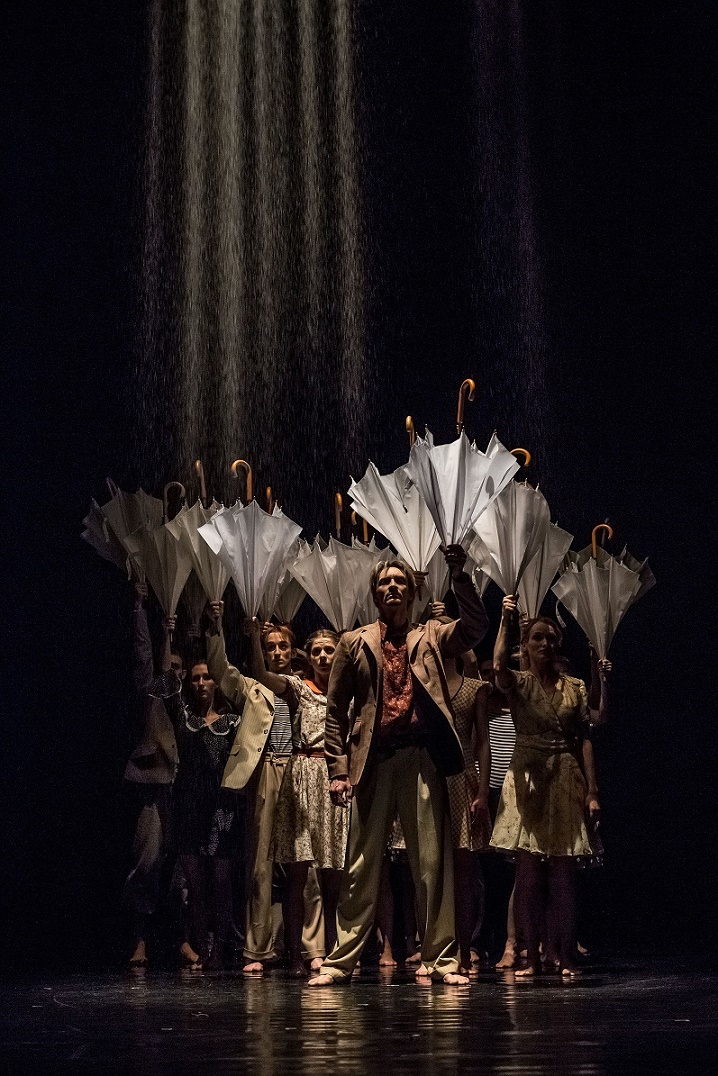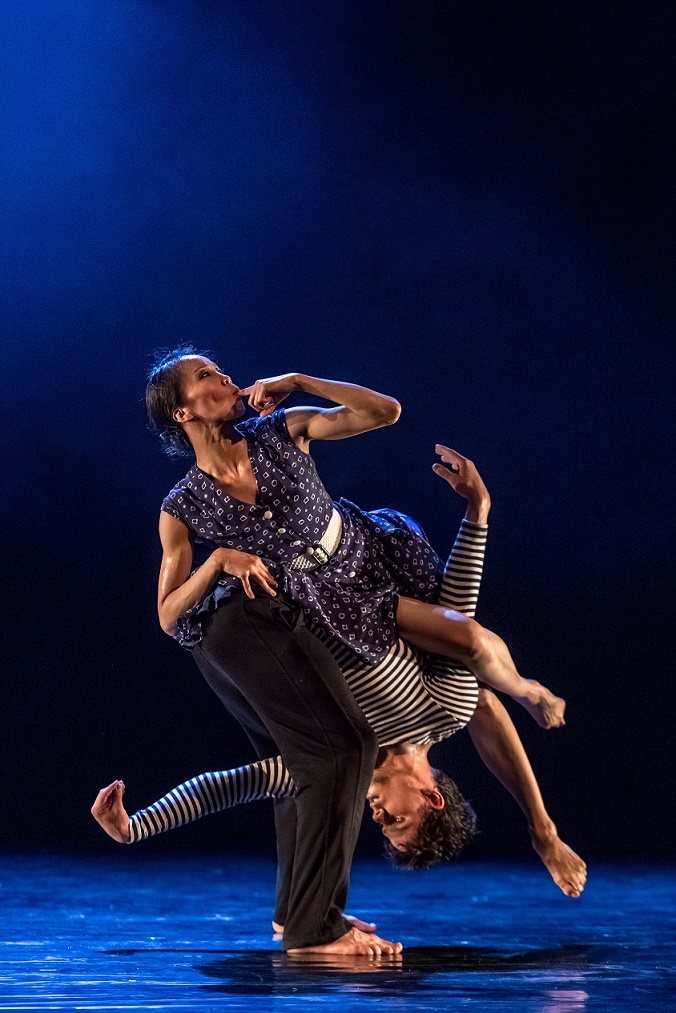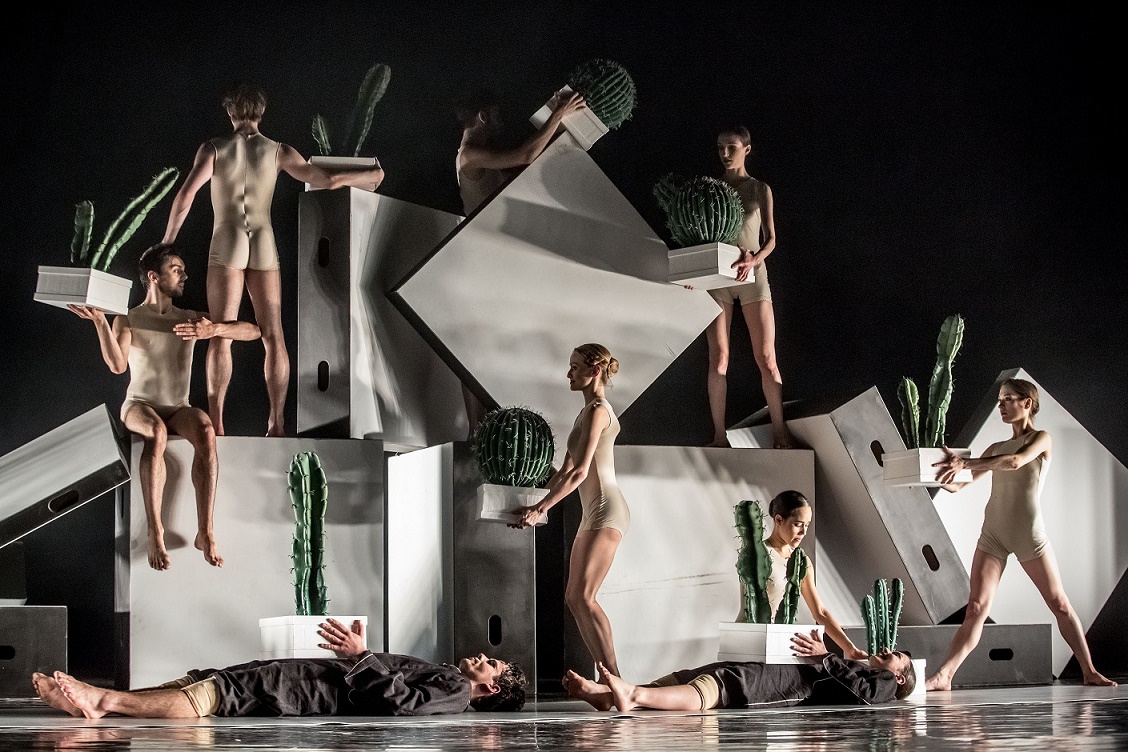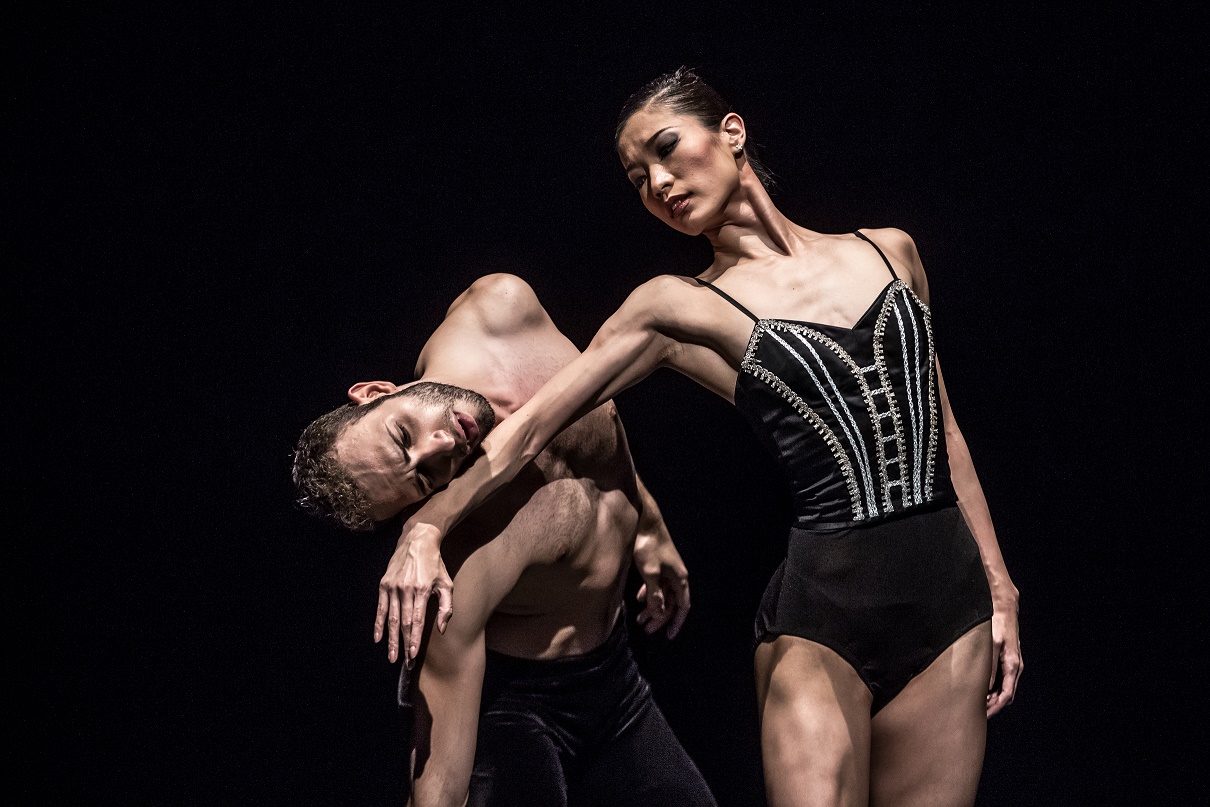Vertigo as a high-energy farewell to the season
 A triple bill is a traditional format on the repertoire of the National Theatre ballet company. The new triptych Vertigo brings lyricism, cold aesthetics and crazy hyperbole in three contrasting pieces of very distinct authors – Radu Poklitaru, Mauro Bigonzetti and Alexander Ekman. It premiered on 9 and 10 June 2016 at the New Stage. Maybe it’s the holidays and restful days coming, maybe it’s the sunny weather that makes the young dancers’ blood boil, but so much energy and joy of dance and movement has been rarely seen on stage in the last months. The more positive a closing of the season this premiere was.
The team of authors is very diverse and it is hard to find any link or common motif between the works or to decode the dramaturgy behind the invitations. But what is more important is that their combination within one programme creates the right amount of tension between the choreographic approaches and can satisfy spectators with different tastes. The Italian choreographer Mauro Bigonzetti is internationally acclaimed creator of the middle generation who drew attention this year especially as the new director of Teatro alla Scalla ballet company. Alexander Ekman is a young, already well-known author, who has quickly coined his own style of dance theatre. He is familiar to the Czech audience, in 2013 the New Stage hosted the Swedish Cullberg Ballet with Ekman’s Triptych – A Study of Entertainment. And his choreographies could also be seen at the festival Zlatá Praha, either on the big screen, or as one of the video screenings (his Swan Lake with five thousand litres of water on stage can hardly be forgotten). The Moldova-born choreographer Radu Poklitaru is a new name for the Czech audience. He is the choreographer and artistic director of Kiev Modern Ballet and his work opens the premiering triple bill.
In the threesome of dance creators, Poklitaru represents something like a Slavonic element and his work confirms it. He deals with relationships on many different levels and let the dancers experience emotions in a very expressive manner, in gestures as well as face expression, sometimes balancing on the edge of caricature. He conceives his opus as a dance suite, framed by the music by Johan Sebastian Bach, from which emerge scenes inspired mostly by folk songs of different nations. But the choreography avoids explicit citations of folk dances, it builds on the canon of well-established modern dance techniques and it must be favourable to dancers because it is dynamic and allows them to vent energy. The dancers first form a closed group from which separate solo dancers, couples or trios, just to join the crowd again. It should symbolize the unity of the mankind, but the motif of blindness that appears twice in the choreography is not clear. Instead of rain, purifying and healing, it is sand that pours into the open umbrellas and buries all human footprints. This futility is engrafted a bit artificially to the high-spirited songs…
A triple bill is a traditional format on the repertoire of the National Theatre ballet company. The new triptych Vertigo brings lyricism, cold aesthetics and crazy hyperbole in three contrasting pieces of very distinct authors – Radu Poklitaru, Mauro Bigonzetti and Alexander Ekman. It premiered on 9 and 10 June 2016 at the New Stage. Maybe it’s the holidays and restful days coming, maybe it’s the sunny weather that makes the young dancers’ blood boil, but so much energy and joy of dance and movement has been rarely seen on stage in the last months. The more positive a closing of the season this premiere was.
The team of authors is very diverse and it is hard to find any link or common motif between the works or to decode the dramaturgy behind the invitations. But what is more important is that their combination within one programme creates the right amount of tension between the choreographic approaches and can satisfy spectators with different tastes. The Italian choreographer Mauro Bigonzetti is internationally acclaimed creator of the middle generation who drew attention this year especially as the new director of Teatro alla Scalla ballet company. Alexander Ekman is a young, already well-known author, who has quickly coined his own style of dance theatre. He is familiar to the Czech audience, in 2013 the New Stage hosted the Swedish Cullberg Ballet with Ekman’s Triptych – A Study of Entertainment. And his choreographies could also be seen at the festival Zlatá Praha, either on the big screen, or as one of the video screenings (his Swan Lake with five thousand litres of water on stage can hardly be forgotten). The Moldova-born choreographer Radu Poklitaru is a new name for the Czech audience. He is the choreographer and artistic director of Kiev Modern Ballet and his work opens the premiering triple bill.
In the threesome of dance creators, Poklitaru represents something like a Slavonic element and his work confirms it. He deals with relationships on many different levels and let the dancers experience emotions in a very expressive manner, in gestures as well as face expression, sometimes balancing on the edge of caricature. He conceives his opus as a dance suite, framed by the music by Johan Sebastian Bach, from which emerge scenes inspired mostly by folk songs of different nations. But the choreography avoids explicit citations of folk dances, it builds on the canon of well-established modern dance techniques and it must be favourable to dancers because it is dynamic and allows them to vent energy. The dancers first form a closed group from which separate solo dancers, couples or trios, just to join the crowd again. It should symbolize the unity of the mankind, but the motif of blindness that appears twice in the choreography is not clear. Instead of rain, purifying and healing, it is sand that pours into the open umbrellas and buries all human footprints. This futility is engrafted a bit artificially to the high-spirited songs…
 To get the right impression from Rain, the distance from which you watched it proved to be fundamental. Taken as a whole, when the audience can concentrate on the form, it seems rather flat, predictable and seen-sometimes-long-ago. What add the esprit are the performances of individual dancer who really enjoy the miniatures. Georgian motifs accompany the micro-story of a couple where the man longs for freedom and the woman wants to tie him; “oriental”, non-identifiable music passage sung as a prayer is dedicated to the theme of manipulation, but also liberation and self-confidence, and the process a girl dominated by two men must undergo. The funny Jewish song (according to its sound one from the Barry sisters’ repertoire) illustrates a short comical number and then comes a strange breaking point with Jacques Brel’s song La valse à mille temps which is neither folk, nor folk song-inspired and accompanied by orchestra. A sentimental duet on a Russian theme and finally a picture of a tumultuous relationship where the woman has the reins in her hands close the parade of relations and characters. At the point when the spectators can watch the individual dancers and are literally attacked by explosions of energy, they will forget all imperfections.
In contrast to the opening piece which is full of expressions, the Vertigo duet by Mauro Bigonzetti is in this point very moderate but it offers an aesthetical experience of high level. Vertigo or passion are not the words suitable to describe this piece; it’s rather purity, line, exactitude, perception, hidden tension. The dancers follow the lines indicated by lights while the rest of the scene is drown in dark so all the attention is centred on them. The choreography toys with borders of balance and centre of gravity in kind of forsythian style, it’s fluent, and emphasizes the range of movement in the mixture of neoclassic and modern components. The dancer on points dressed only in black, simply decorated costume and her tople
ss partner resemble sculptures set in motion. The choreography demands suspension and concentration so the relationship which can be read from their common interaction results from the motive material, they support each other. Few gestures or a brief emplacement of head on the partner’s body are the subtle details which add sentiment to the highly aesthetic spectacle. Both casts live through the choreography and there is a bond formed between them – especially during the second premiere the technique of the dance was well-balanced with tenderness. Music by Dmitrij Šostakovič is complementary to the temperance of the whole piece.
To get the right impression from Rain, the distance from which you watched it proved to be fundamental. Taken as a whole, when the audience can concentrate on the form, it seems rather flat, predictable and seen-sometimes-long-ago. What add the esprit are the performances of individual dancer who really enjoy the miniatures. Georgian motifs accompany the micro-story of a couple where the man longs for freedom and the woman wants to tie him; “oriental”, non-identifiable music passage sung as a prayer is dedicated to the theme of manipulation, but also liberation and self-confidence, and the process a girl dominated by two men must undergo. The funny Jewish song (according to its sound one from the Barry sisters’ repertoire) illustrates a short comical number and then comes a strange breaking point with Jacques Brel’s song La valse à mille temps which is neither folk, nor folk song-inspired and accompanied by orchestra. A sentimental duet on a Russian theme and finally a picture of a tumultuous relationship where the woman has the reins in her hands close the parade of relations and characters. At the point when the spectators can watch the individual dancers and are literally attacked by explosions of energy, they will forget all imperfections.
In contrast to the opening piece which is full of expressions, the Vertigo duet by Mauro Bigonzetti is in this point very moderate but it offers an aesthetical experience of high level. Vertigo or passion are not the words suitable to describe this piece; it’s rather purity, line, exactitude, perception, hidden tension. The dancers follow the lines indicated by lights while the rest of the scene is drown in dark so all the attention is centred on them. The choreography toys with borders of balance and centre of gravity in kind of forsythian style, it’s fluent, and emphasizes the range of movement in the mixture of neoclassic and modern components. The dancer on points dressed only in black, simply decorated costume and her tople
ss partner resemble sculptures set in motion. The choreography demands suspension and concentration so the relationship which can be read from their common interaction results from the motive material, they support each other. Few gestures or a brief emplacement of head on the partner’s body are the subtle details which add sentiment to the highly aesthetic spectacle. Both casts live through the choreography and there is a bond formed between them – especially during the second premiere the technique of the dance was well-balanced with tenderness. Music by Dmitrij Šostakovič is complementary to the temperance of the whole piece.
 When it comes to Ekman’s opus called Cacti, it is as expected spectacular dance theatre which is to be looked on with distance and exaggeration. The choreographer focuses on difficulty of conceptual art. It’s easy to hide creative helplessness behind this word and right that - the other side of contemporary arts – is what the young creator decides to humour: How tell apart when creators form grave messages from the situation when they use pretty words just to cover empty subject? He plays the spectator with seemingly sophisticated word, the symbology of black and white colour and finally it comes to artificial cactuses, which can make sense…or not at all. All in all it’s not important because Ekman lets creative fantasy go wild and toys with everything – motion, music, lights and scene in mad sequence of impressions. Some parts can be taken not only as exaggeration but seriously as well. In the beginning, when a voice describes dancers as instruments of the orchestra, it’s meant as a cliché, on the other hand, the choreographer himself uses the dancers as his own instruments, and he does this very well.
Hans Krása string quartet, which accompanies the first part, creates the sound scenery as well as the dancers do, because they clasp and stamp and make other noises and this way they bring in special rhythm. Their movements are constricted because of low white pedestals, but even so, their short acts are explosive and variable. The choreography is also accompanied by records and interpretations of pieces by Franz Schubert, Joseph Hayden and Ludwig van Beethoven. The members of the string quartet do not only make music, they also take part in the spectacle. As the choreography evolves, the changes of the light are more frequent and the dancers are like figures on a chessboard illuminated by a flashlight. A great dose of acting was expected of everyone. The choreographer also manages to make fun of the creative process and of schematization which is greatly used these days for motion variations and which sometimes does not make sense – not even to the creators. We witnessed a ritual which relativizes itself. A great conclusion which can make your head spin.
When it comes to Ekman’s opus called Cacti, it is as expected spectacular dance theatre which is to be looked on with distance and exaggeration. The choreographer focuses on difficulty of conceptual art. It’s easy to hide creative helplessness behind this word and right that - the other side of contemporary arts – is what the young creator decides to humour: How tell apart when creators form grave messages from the situation when they use pretty words just to cover empty subject? He plays the spectator with seemingly sophisticated word, the symbology of black and white colour and finally it comes to artificial cactuses, which can make sense…or not at all. All in all it’s not important because Ekman lets creative fantasy go wild and toys with everything – motion, music, lights and scene in mad sequence of impressions. Some parts can be taken not only as exaggeration but seriously as well. In the beginning, when a voice describes dancers as instruments of the orchestra, it’s meant as a cliché, on the other hand, the choreographer himself uses the dancers as his own instruments, and he does this very well.
Hans Krása string quartet, which accompanies the first part, creates the sound scenery as well as the dancers do, because they clasp and stamp and make other noises and this way they bring in special rhythm. Their movements are constricted because of low white pedestals, but even so, their short acts are explosive and variable. The choreography is also accompanied by records and interpretations of pieces by Franz Schubert, Joseph Hayden and Ludwig van Beethoven. The members of the string quartet do not only make music, they also take part in the spectacle. As the choreography evolves, the changes of the light are more frequent and the dancers are like figures on a chessboard illuminated by a flashlight. A great dose of acting was expected of everyone. The choreographer also manages to make fun of the creative process and of schematization which is greatly used these days for motion variations and which sometimes does not make sense – not even to the creators. We witnessed a ritual which relativizes itself. A great conclusion which can make your head spin.Written from the first and second premiere held on 9th and 10th June 2016, the New Stage of the National Theatre.
 Rain
Choreography: Radu Poklitaru
Rain
Choreography: Radu PoklitaruMusic: Jacques Brel, folk songs, Johann Sebastian Bach
Costumes: Anna Ipatieva
Lighting design: Olena Antochina
Sound: Alexader Kurij
Assistants of choreography: Anatolij Kozlov, Serhii Kon and Anna Herus
Ballet Masters: Nelly Danko and Alexej Afanassiev Vertigo Choreography: Mauro Bigonzetti
Music: Dmitrij Dmitrijevič Šostakovič
Lighting design: Carlo Cerri
Costumes: Mauro Bigonzetti
Assistants of choreography: Carlos Manuel, Prado de Sousa
Ballet Masters: Alexander Katsapov a Tereza Podařilová Cacti
Choreography: Alexander Ekman
Music: Joseph Haydn, Ludwig van Beethoven, Franz Schubert and Andy Stein
Performed by: Hans Krása Quartet
Lighting design: Tom Visser
Costumes: Alexander Ekman
Scene: Alexander Ekman a Tom Visser
Author of the text: Spenser Theberge
Assistants of choreography: Fernando Troya
Ballet Masters: Radek Vrátil a Michaela Černá
Translation: Tereza Cigánková


